AMD's A10-5750M Review, Part 1: The APU and Radeon HD 8650G Performance
by Dustin Sklavos on June 28, 2013 12:00 PM ESTGaming Performance
While I've included the Enthusiast level benchmark results in Bench, it's worth noting that Richland is still nowhere near powerful enough to handle gaming at 1080p and 4xMSAA. AMD's A10-5750M APU has two primary jobs to complete with the IGP isolated: it has to be faster than Trinity and faster than Haswell. The former is easy enough, but Haswell is more of a moving target. The only reprieve AMD seems to be getting on this front is the unusual rarity of GT3-enabled parts in the market.
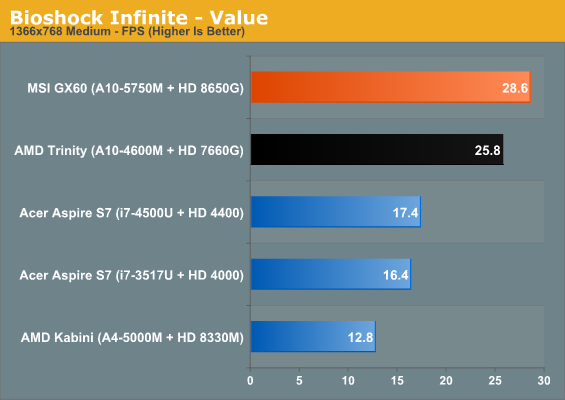
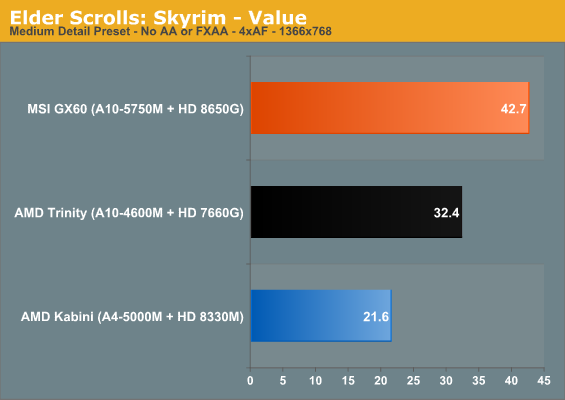
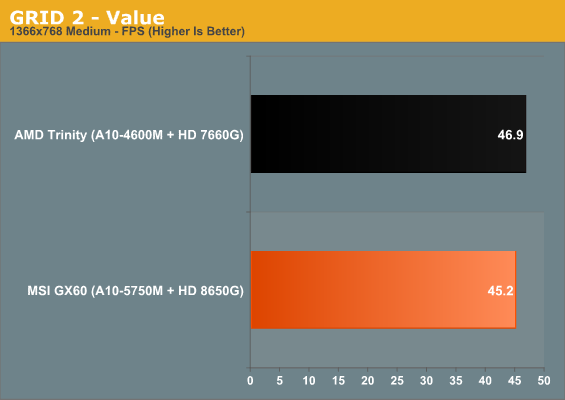
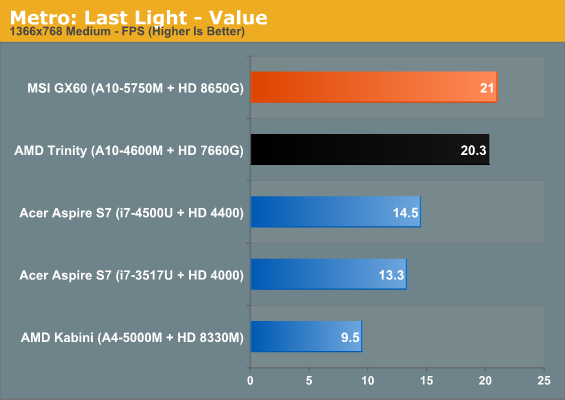
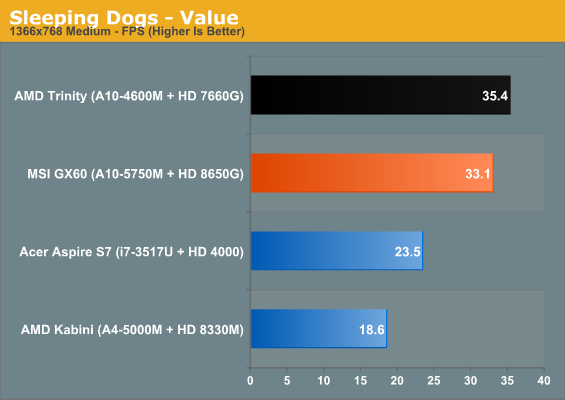
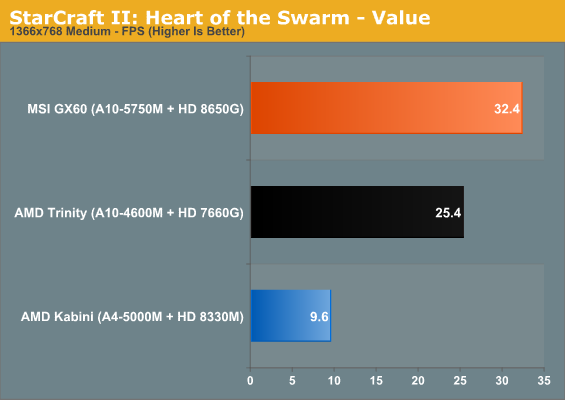
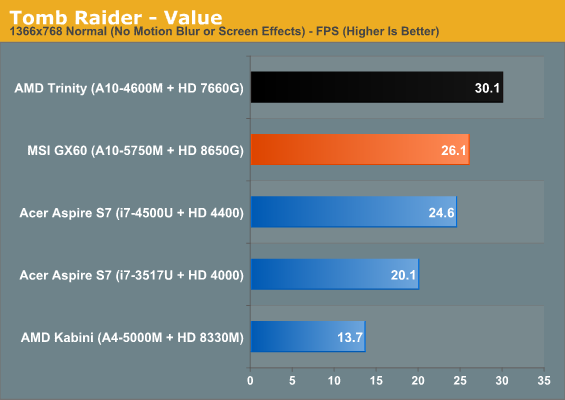
Interestingly, while Richland is consistently faster than Haswell and Ivy Bridge, often by a healthy margin, it actually trades blows with Trinity. This could be the result of either a difference in drivers or the newer version of Turbo Core being tuned to favor the CPU more aggressively. My reason for suspecting Turbo Core is boosting the CPU more frequently than the GPU is this: Skyrim and StarCraft II are both frequently CPU-limited, and both produce the largest jumps in performance from the preceding generation. Without more Richland-based notebooks to test it's going to be hard to ferret out what's going on, if this is just specific to the GX60 or if mobile Richland's turbo core really does skew more aggressively towards the CPU.
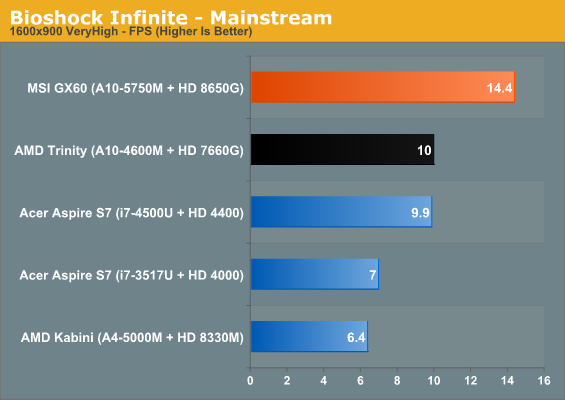
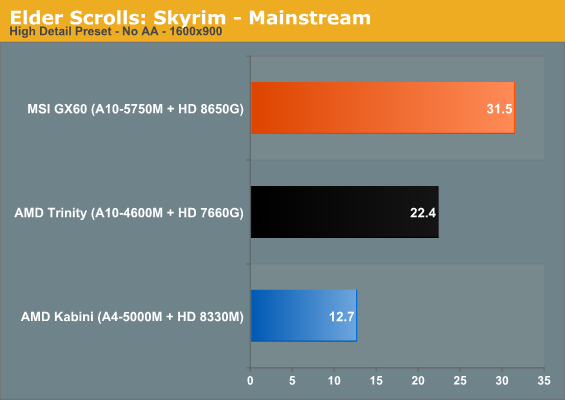
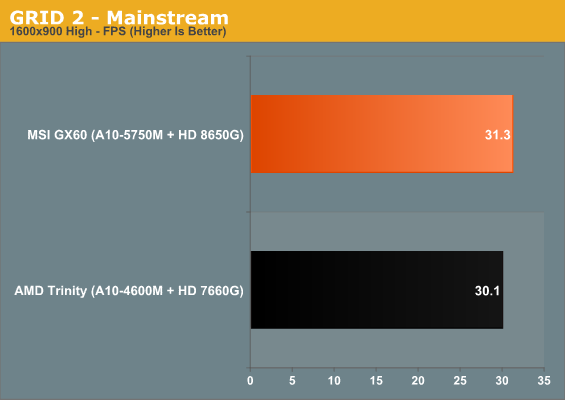
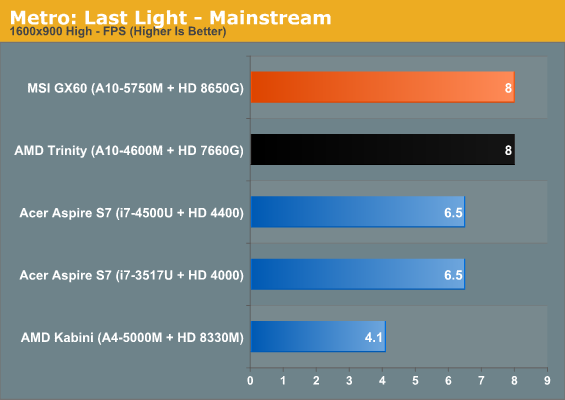
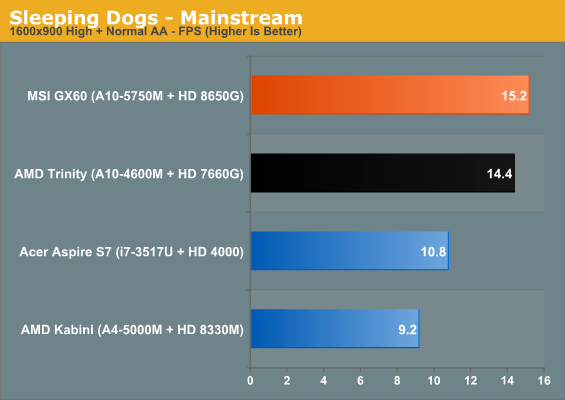
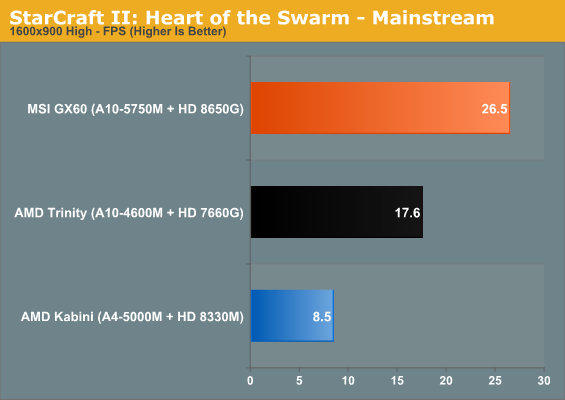
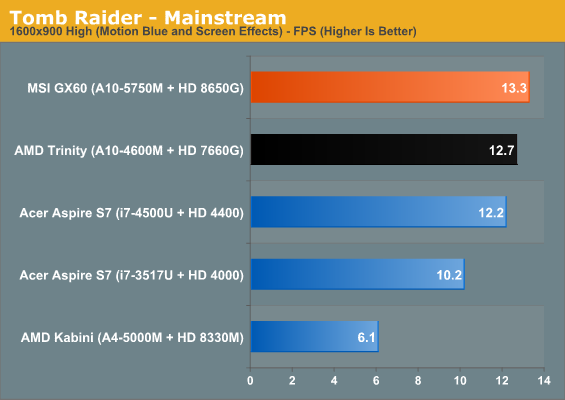
Impressively, Richland is able to produce substantial gains on Trinity in our CPU-bound benchmarks, vaulting Skyrim and StarCraft II into the realm of playability even at our Mainstream settings. Depending on the games you play, Richland could be a major improvement on the last generation.










82 Comments
View All Comments
monstercameron - Friday, June 28, 2013 - link
don't think it is fair comparing TDPs, we all know that they mean slightly different things for the two, intel 17W parts blow past 30+ watts from time to time.andrewaggb - Friday, June 28, 2013 - link
Ultimately the power measurement's that matter are battery life in various use cases and how much heat/active cooling is required. 35W under full gpu load is probably acceptable as long as the idle power usage is competitive with haswell. (I'm doubtful that it is though)monstercameron - Friday, June 28, 2013 - link
yeah idle is where haswell has richland and kabini beat...Khato - Friday, June 28, 2013 - link
While I doubt anyone would dispute the fact that Intel allows its processors to turbo past their specified TDP (considering that, ya know, it's kinda part of Intel's specifications) your argument would be better served by providing actual numbers instead of inflating them into the realm of fantasy. Specifically, Notebookcheck's power numbers for systems using the i7-3667U show a delta of roughly 23W between maximum idle and maximum load. Meanwhile their review of the A10-4600M shows a delta of 44W between idle and load.Regardless, going over specified TDP isn't really an issue, in fact it's typically a good thing. But it definitely means that actual power draw must be considered when comparing performance.
monstercameron - Friday, June 28, 2013 - link
really bro? http://www.notebookcheck.net/Review-Fujitsu-LifeBo...idle 9W, maxed out 40W...and that is only an i5.
Darkstone - Friday, June 28, 2013 - link
Download throttlestop. Click on the button that says 'tpl'. Expected output: power limit #1: 17W. power limit #2: 21W. Turbo time: 28s.Review the stresstest screenshot in this review:
http://www.notebookcheck.net/Review-Acer-Aspire-M3...
max
Max. package power, 19w, current package power, 16.5w.
Although the power usage can definitely exceed the TDP, it only does so for a short time. The effect on games or benchmarks taking >5 minutes is too small to make a difference. A processor with a TDP of 45w can be cooled by a heatsink rated at exactly 45w, but it might not always enter turbo mode for the full amount of time.
But that's not all, this review compares the graphics performance of an 17W tdp CPU with an 35W AMD part. The intel ULV parts are heavy power constrained. An 35W i5 part would probably be ~ 30% faster in games. Review notebookcheck, for example, starcraft 2 17W TDP ivy bridge: 31 fps. 45W part: 41 fps. Starcraft 2 does not scale above 2 cores. Check Dead Space or Hitman Absolution for more numbers that tell the same story.
Khato - Friday, June 28, 2013 - link
Bravo at finding a single example of a 17W SKU behaving abnormally in their review database. If you notice I specified a particular part which outperforms the one included in your linked review, and all reviews notebookcheck has done with that part show a delta of roughly 23W between maximum idle and maximum load.Just because there's an outlying result doesn't mean that it's the norm.
wumpus - Friday, June 28, 2013 - link
Are you seriously suggesting that Intel draws more power than TDP for long enough to soak the thermal mass of the CPU+recommend heat sink? The whole point of TDP means "thermal design power", and needs to be taken into account only for heatsink and mobile manufacturers.If you want to know what maximum current an Intel chip will draw, pull the datasheet (not the stuff made for marketing or consumers: it should be a pdf with several hundred pages. If you really want to build a motherboard; sign the NDA for the real one with the bugs included). Intel will list the requirements for the motherboard's power supply, and don't expect them to draw more than that (even then they may include a certain capacitance and frequency limits for the power supply. Intel is still free to draw however much they wish as long as the average within one period of the switching frequency is within the limits and can be supplied by the capacitance).
Breaking the specs is huge sin in this industry. Breaking what consumers think the specs are is irrelevant.
name99 - Friday, June 28, 2013 - link
This reminds me of the whining that occurred when Intel first added turbo support to its CPUs --- apparently it's "unfair" to use the laws of thermal physics to improve the performance of devices.Look, Intel has done an INCREDIBLE job of allowing its devices to run at short high speed bursts, for responsiveness, while generally using extremely low power. This is a tradeoff that meets most people's needs very well, even if it's not an appropriate tradeoff for a server chip that's going to be running at 95% utilization 24/7.
Others should be emulating Intel, not complaining that what they are doing is "unfair".
MrSpadge - Friday, June 28, 2013 - link
Excellent posts here by you, wumpus, darkstone and others!